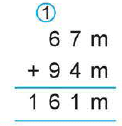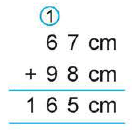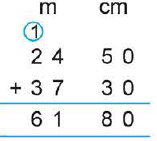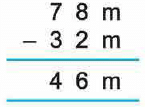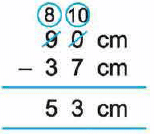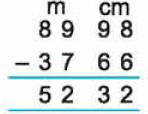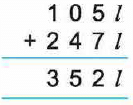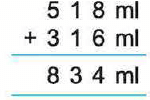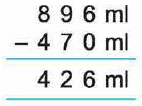Class 3 Maths - Measurement - Question Answers
Question 1: Draw a line 5 cm long.
Step 1: Put a mark '.'.
Step 2: Keep the scale so that its 0 aligns with the mark '.'.
Step 3: Keep the pointed end of a pencil at 0. Draw along the scale till you reach 5.
Question 2: Convert the following lengths into centimetres:
(a) 18 m
(b) 26 m
(c) 8 m 52 cm
(d) 15 m 72 cm
We know that 1 m = 100 cm. So,
(a) 18 m = 18 x 100 cm = 1800 cm.
(b) 26 m = 26 x 100 cm = 2600 cm.
(c) 8 m 52 cm = 8 x 100 cm + 52 cm
= 800 cm + 52 cm = 852 cm.
(d) 15 m 72 cm = 15 x 100 cm + 72 cm
= 1500 cm + 72 cm = 1572 cm.
Question 3: Express the following lengths as metres and centimetres:
(a) 526 cm
(b) 705 cm
(c) 1542 cm
We know that, 100 cm = 1 m. So,
(a) 526 cm = 500 cm + 26 cm
= 5 m + 26 cm = 5 m 26 cm.
(b) 705 cm = 700 cm + 5 cm
= 7 m + 5 cm = 7 m 5 cm.
(c) 1542 cm = 1500 cm + 42 cm
= 15 m + 42 cm = 15 m 42 cm.
Question 4: Add 19 m and 50 m.
Question 5: Add 67 m and 94 m.
Question 6: Add 67 cm and 98 cm.
Question 7: Add 24 m 50 cm and 37 m 30 cm.
Question 8: Subtract 32 m from 78 m.
Question 9: Subtract 37 cm from 90 cm.
Question 10: Subtract 45 m 60 cm from 98 m 75 cm
Question 11: Subtract 37 m 66 cm from 89 m 98 cm
Question 12: Amit had 5 m long rope. He tied 1 m 75 cm long rope to it. Find the total length of the rope.
The length of rope that Amit had initially = 5 m
The length of rope tied to it = 1 m 75 cm
Total length of rope = 5 m + 1 m 75 cm
Hence, the total length of the rope = 6 m 75 cm.
Question 13: A piece of cloth measures 57 m 65 cm. A piece measuring 38 m 42 cm is cut from it. What length of the cloth is left?
The length of the piece of cloth = 57 m 65 cm
The length of the cloth cut = 38 m 42 cm
The length of the cloth left = 57 m 65 cm - 38 m 42 cm
Hence, the length of cloth left = 19 m 23 cm.
Question 14: Madhavi bought 3 kg of potatoes and 7 kg of onion. Find the total weight of the vegetables bought by Madhavi.
Question 15: A gas cylinder weighs 26 kg. If the cylinder weighs 7 kg after 7 days, then how much gas has been used?
Question 16: (a) Add 105 l and 247 I.
(b) Add 518 ml and 316 ml.
(c) Subtract 4 70 ml from 896 ml.
(a)
(b)
(c)
|
18 videos|120 docs|25 tests
|
FAQs on Class 3 Maths - Measurement - Question Answers
| 1. What is measurement in math? |  |
| 2. Why is measurement important in everyday life? |  |
| 3. What are some common units of measurement? |  |
| 4. How can measurement be used to solve real-life problems? |  |
| 5. How can children practice measurement skills? |  |


